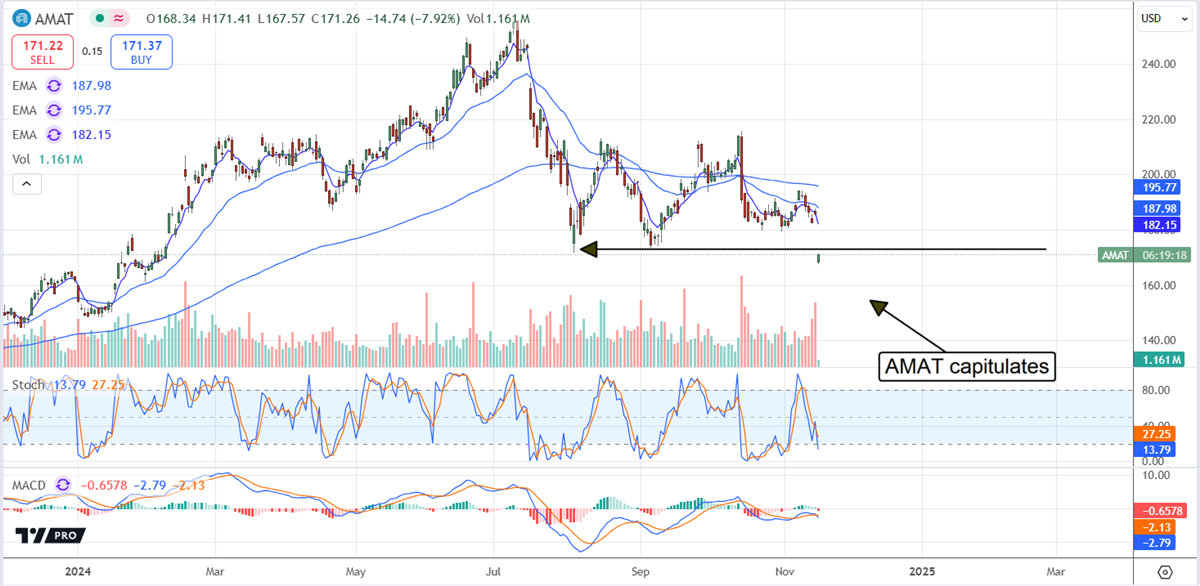Ticker Reports for November 18th
Is Monolithic Power Systems a Screaming Buy After Near 40% Drop?
Monolithic Power Systems (NASDAQ: MPWR) is a chip stock that isn’t nearly as talked about as some other companies in its industry, like NVIDIA (NASDAQ: NVDA) or Taiwan Semiconductor Manufacturing (NYSE: TSM). But that doesn’t mean the company hasn’t had great success over the years. It has been able to amass a value of nearly $28 billion, a number that looks much smaller after the last few weeks. Since Oct. 29, the company has lost over 39% of its value.
However, regardless of what the market says, it’s fair to question whether this massive drop justifies itself. Has the company’s intrinsic value really dropped by $18 billion in a mere two weeks, or is the market overreacting to recent news?
Monolithic’s Chips Power the Industry
First, it is important to understand what Monolithic does. Monolithic designs power chips. These chips regulate the use of power in other chips, like an NVIDIA AI accelerator, for example. This ensures that chip has the right amount of power, in the right places, at the right time, so that it can perform properly and efficiently.
Because Monolithic’s chips regulate the power of other chips, they are needed in all parts of the semiconductor industry. This is evident when looking at the company’s financials. It generates significant amounts of revenue from enterprise data, storage, automotive, consumer, and industrial semiconductor applications.
Two Pieces of Bad News Tank Monolithic, but Wall Street Appears Sanguine
The company’s Q3 earnings report on Oct. 30 certainly has caused concern in the market. The company's shares dropped massively on earnings. They beat expectations for revenue and adjusted earnings per share (EPS). However, the company failed to raise its guidance above expectations, the source for the drop.
There was more bad news surrounding Monolithic. An Edgewater Research report said Monolithic may lose orders to power NVIDIA's latest Blackwell chips. It cited technical performance issues as the cause. This sent shares down even more than the earnings report. Still, Needham and Oppenheimer did not change their price targets based on this.
In conversations with Needham, Monolithic defended itself against this report. It said it wasn’t aware of these technical issues and hadn't received any order cancellations from NVIDIA. The company pushed back further in another report. It stated that with Blackwell production in late stages, notification of these changes to the supply agreement would be required. It has not received such notification.
The change in Wall Street price targets has not been even close to the stock’s drop in price. The target changes from TD Cowen, Needham, and Truist have fallen an average of just 9% since Oct. 30. When adding in the price targets from three more analysts that either initiated the stock or didn’t change their target, the average price target sits at $875. Based on a Friday afternoon share price of $566, that implies an upside in the shares of 55%. At first glance, it's hard to reckon that Monolithic Power Systems didn’t just go on sale.
With Other Parts of the Business Rebounding, Monolithic May Be Cheap
Another concerning point is that the company's enterprise data revenue declined slightly from the previous quarter. This isn’t great to see, as this part of the company’s business is what has been driving growth. However, enterprise data revenue was still up 86% year-over-year. Every other segment of the business saw negative year-over-year growth for at least the last three quarters.
However, in Q3, all other segments returned to growth on a year-over-year basis and increased revenues from the previous quarter. This signals that other parts of the business enterprise data growth slows, are picking up . This is important because although enterprise data revenue has grown exponentially, it only makes up 30% of total revenue.
Overall, I see the massive drop in Monolithic Power stock as an opportunity. The analyst’s price target reactions and statements from the company throw cold water on the claims made by Edgewater. Additionally, the company’s diversified business makes the risk in the enterprise data segment less worrisome. This doesn’t mean that shares can’t keep dropping from here, but this is still a strong business whose products are needed in every part of the chip market. It appears to me that shares have gone on discount.
Deloitte's #1 software company price changing
Get in on the biggest disruption to smartphones in over a decade. Reg A investment now open.
Claim Exclusive 100% Bonus: $0.25/Share*Applied Materials Market Capitulates: Now is the Time to Buy
The Applied Materials (NASDAQ: AMAT) market capitulated following the Q4 results and guidance, cratering in premarket action to gap lower and open near break-even for the year. The capitulation was caused by lackluster guidance, but the bar was high, and Applied Materials failed to impress. The takeaway for investors is that this company is well-positioned for long-term growth, has sustained positive cash flow and capital returns, and is now trading at rock-bottom prices.
Applied Materials' focus on materials engineering is critical to advancing semiconductor technology. The increasingly complex microchips rely on miniaturization and, in turn, durability, which are areas in which AMAT excels. The chips need to be more durable the smaller they get because of AI's manufacturing process and intense power loads.
Applied Materials is the leader in this field because it has the most comprehensive portfolio of tools for modifying materials at the atomic level. Its tools and services span semiconductor manufacturing, providing an integrated, one-stop solution for semiconductor manufacturers and labs. Here are three reasons why now is a good time to buy it.
Applied Materials had a Good Q4 and 2024
The first reason Applied Materials is a buy is that it had a good year, with revenue and earnings exceeding the consensus estimates and guidance improving throughout. The take in Q4 topped $7.0 billion in consolidated revenue, good for a gain of nearly 5% to outpace MarketBeat’s reported consensus by over 100 basis points and set a company record.
The strength was driven by growth in two of three segments, with the weakness centered on Display, which is only 3% of the net. Services grew by 11%, while the semiconductor solutions segment, 73% of the revenue, grew by 6%. Within the semiconductor solutions segment, Foundry was strongest taking 400 basis points of share contribution from DRAM and momentum is expected to build in Q1. The guidance is forecasting growth to accelerate.
Applied Materials Business Strong Cash Flow Funds Healthy Capital Return
The second reason Applied Materials is a buy is that the business is operationally sound and drives value for its investors. The company has strong margins, robust cash flow, a healthy balance sheet, and the ability to pay investors. Highlights from Q4 include record operating income with a 29.3% margin, $2.58 billion in cash from operations, a 75% increase in quarterly free cash flow (flat for the year), and free cash flow of $2.168 billion.
Capital returns are 65% of the free cash flow for the year, with both expected to remain strong in 2025. Capital returns include a dividend and buybacks. The dividend is below the broad market average regarding its yield, about 1%, trading at long-term lows, but the distribution is safe at less than 20% of the earnings and can be expected to grow. The buybacks are more substantial, more than 3X the dividend on a dollar basis, and reduced the share count by 1.6% for the quarter and 1.3% for the year.
The Guidance is Good and Likely Cautious
The guidance for FQ1 was mixed and tepid regarding the consensus estimate but no less good for investors. The company is guiding for sequential and YOY growth, with YOY growth to accelerate from Q4. Revenue is expected to be near $7.15 billion at the mid-point compared to $7.25 billion forecasted by analysts, which is a slim margin of error and easily overcome. Applied Materials has beaten its revenue target in the last ten consecutive quarters and will likely do so again.
Even so, the earnings guidance is good, with adjusted EPS expected above the consensus for the quarter. With revenue expected to be strong, the final result for earnings will likely also exceed the company’s guidance. The critical detail is that the cash flow will grow, improving the balance sheet health and capital return outlook.
As it is, the balance sheet is a fortress with cash and assets growing, liabilities under control, and equity up 16%. Leverage remains low, the company is net cash, and the trends supporting the balance sheet health will continue in 2025.

LAST CHANCE? Jump on this IRS loophole now
If you own Gold, you're going to love this!
But if you think you missed out, you'll want to see why you still have a chance!
Before Trump was elected, Gold shot up to the highest prices it's ever seen…
3 Ultra-High Dividend Yield Stocks for the New Year
Amid a major political shift in the United States, investors may understandably be uncertain about how to distribute their assets. Some anticipate a new administration to be a boon for stocks thanks to loosened regulations and the potential for lower corporate taxes. Others anticipate a return to a highly inflationary environment—or worse—due to tariffs and labor shortages, among other factors.
Investors more bearish about the market environment in the coming quarters may consider dividend stocks. Because these firms pay out regular passive income, investors may be more likely to hold on to these stocks through a falling market, making them more stable for longer. While no company is guaranteed to escape a market downturn unscathed, some investors choose dividend-paying firms as one of the safest ports in a storm.
Financial firms have been a particular focus for many—including institutional investors—both before and after the U.S. election. Hedge funds poured money into financial stocks throughout the summer as investors anticipated a beneficial environment into the new year. Prospect Capital Corp. (NASDAQ: PSEC) stands out among financial companies for its high dividend yield of 16.3%.
Real estate investment trusts (REITs) are a category of company known for their strong dividend payouts as well. AGNC Investment Corp. (NASDAQ: AGNC) and Rithm Capital Corp. (NYSE: RITM) are among the REITs with the highest dividend yields, with 15.0% and 9.3%, respectively.
1. Prospect Capital: Dividend Trim History, But Advantages Over Other BDCs
Prospect Capital is a business development company (BDC) providing services to middle-market companies. BDCs, like REITs, have a mandate to make regular dividend payments, and Prospect Capital's market capitalization of $2 billion allows it to have a wider portfolio than many other companies in this category. Its debt-to-equity ratio of 0.68 is strong, and its price-to-sales ratio of 2.24 is competitive as well.
On the dividend side, Prospect's astronomical dividend yield may seem too good to be true, and indeed there is reason for investors to exercise caution. The firm has cut its dividend multiple times in the last decade, including most recently in November 2024. This latest trim sent PSEC shares plummeting after already sliding a bit throughout the past year—they are now down more than 22% in that time. Investors willing to take a chance on this firm in case it does get some positive news that sends the stock back upward could reap the rewards, although its history of underperformance in recent years should give pause.
2. AGNC Investment Corp: Dipping Share Price Makes For Reinvestment Opportunity
AGNC is a REIT dealing in residential mortgage-backed securities that could be poised for success if mortgage rates continue to move lower. Indeed, shares are up nearly 11% in the last year, and that's after they've fallen since mid-October amid the election season and increased uncertainty about the upcoming rates environment. On the plus side, a falling share price has helped bring AGNC's price-to-book ratio down to 1.06, making it a more affordable option.
AGNC's history of share price declines extends back many years, and its dividend payouts trend alongside stock price. Investors throughout that period may have been better off reinvesting dividends in order to maximize total return. While most investors seek out dividend stocks for a passive income stream, those looking to reinvest may be drawn to AGNC's sky-high yield.
3. Rithm Capital: Diversified REIT With Room to Grow
Rithm Capital also deals in mortgages, like AGNC, but has a wider scope beyond that—the REIT includes consumer loans and both residential and commercial real estate in its portfolio as well. This diversification helps mitigate risk by spreading exposure across various asset classes, making it more resilient to sector-specific downturns.
The company has a record of several dividend increases over the last four years and currently has annualized three-year dividend growth of 26%. Additionally, its consistent dividend payouts provide income-focused investors with a reliable passive income stream, making it particularly appealing in uncertain markets.
Rithm is a favorite REIT among Wall Street analysts, who rate the stock a Moderate Buy and expect upside potential of more than 19%. This optimism is supported by its strong price-to-book ratio of 0.86, which suggests undervaluation and room for significant growth.
Caution Regarding Dividend Yields
High dividend yields can sometimes signal that a company's shares have plunged and it may be forced to reduce or halt dividend payments. All three of the companies listed here are obligated to pay out dividends, but concern about long-term performance is still warranted, particularly in the case of both Prospect and AGNC.






0 Response to "🌟 Is Monolithic Power Systems a Screaming Buy After Near 40% Drop?"
Post a Comment